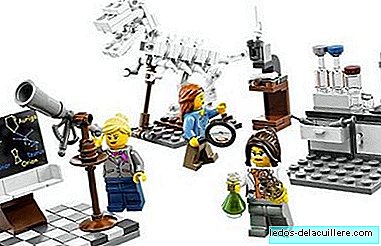
It's not about being obsessed with cleaning or trying to have an aseptic environment, but we can pay attention to those places that accumulate more germs. In this way we can influence its cleanliness or ensure that babies and children do not play with certain objects, to avoid risks.
Germs are bacteria, viruses, fungi and microscopic protozoa that can cause disease. Washing your hands often prevents many infections, so this simple preventive measure should be the first.
It's not about sterilizing the house, clothes, food utensils ... because the excess of hygiene weakens the immune system and we cannot pretend to eliminate microorganisms with which we have all grown. In addition we cannot live in a bubble and the risk is not only in the home.
However, we may stop to think for a few seconds before allowing the baby to bite the remote control, or to play with the phone, with the bath towel, with the sponge, with the shoes ...
Places with the highest accumulation of germs
According to the American organization Keeping It Kleen, these are the places with the highest accumulation of germs:
The remote control, that inseparable companion that lives in the living rooms of the houses (or in several rooms) and that is manipulated by everyone and placed anywhere. Charles Gerba, a professor of microbiology at the University of Arizona, found E. coli bacteria in a large number of these devices.
Cell phone. According to a study conducted in the United Kingdom by the London School of Hygiene and Tropical Medicine, 16% of mobile phones are infected with traces of human feces and E. coli (responsible for gastrointestinal infections), as well as with Staphylococcus aureus (which may cause skin conditions, pneumonia and meningitis).
In relation to the above, the touch screens of any device (smartphones, tablets ...) also accumulate multiple germs and fecal bacteria, easily passing from hand to hand.
Handbag, that great ally that can enclose anything when we have babies, also becomes an important focus of germs. An investigation by the microbiologist Amy Karen in Salt Lake City, revealed that almost all the objects analyzed were contaminated with Pseudomonas, which cause eye infections, and Salmonella, E. coli, fecal matter and Staphylococcus aureus, which triggers irritations in the skin. Interestingly, leather bags are cleaner than cloth bags.

The pillow after two years of use includes multiple germs, dust, mites, secretions of these animals, dead skin and saliva. The study that determined these unwanted "neighbors" of dreams was carried out in the main English hospitals, since the pillows were associated with the proliferation of infections and bacteria among which is the Staphylococcus Aureus.
The supermarket cart: It is worth cleaning it with a disinfectant wipe before sitting on it to the baby or child. According to research conducted at the University of Arizona, there are more germs in a cart than in a public restroom; 72% of those examined had traces of fecal matter and 50% had E. coli.
The shoes, for the floor. Perhaps in this we have to be glad that the children do not want to take them. Of course, better keep them out of reach. After three months of wear, 13% of shoe soles have traces of E. coli and 90% have fecal matter
The interior of the car, and especially the steering wheel: A study by Queen Mary University in London revealed that the steering wheel has nine times more bacteria than a public restroom seat. In the rest of the car more than 700 types of germs can be multiplied.
The bathroom, although not the main focus of germs, does include elements such as the bathtub, the sponge, the handles of the taps, the door handle or the bath towel to which attention should be paid. The baby changing table, especially that of public toilets, must be used on a protection.
Other favorite objects and places for the proliferation of germs are coins and bills, ATMs, restaurant menus, condiment dispensers, computer keyboard and mouse, school supplies, video game consoles, the floor ...
As we see, it would be impossible to keep all these objects and places with more germ accumulation controlled and perfectly sterilized. But let's not forget to keep basic precautions to prevent many infections and infections in our children and in ourselves.












